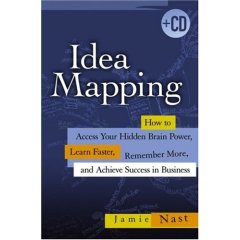An Idea Mapping Success Blogs Weblog
Why I Use the Term Idea Mapping Over Mind Mapping?
11Jun2012 Filed under: Certified Idea Mapping Instructors, Dave Gunby, Differences Between Idea Mapping and Mind Mapping, idea mapping book Author: Jamie Nast In my May 14, 2009 posting I explained what I consider to be small but significant differences between Idea Mapping and Mind Mapping. I expanded a bit on one of those reasons in my May 7, 2012 posting about how Idea Mapping breaks the Mind Mapping Laws laid out in the many books on Mind Mapping. As promised in that posting I plan to talk specifically about some of these Mind Mapping Laws that aren’t always necessary or appropriate. But before I embark on that journey I wanted to answer the question posed in the title of this posting.
In my May 14, 2009 posting I explained what I consider to be small but significant differences between Idea Mapping and Mind Mapping. I expanded a bit on one of those reasons in my May 7, 2012 posting about how Idea Mapping breaks the Mind Mapping Laws laid out in the many books on Mind Mapping. As promised in that posting I plan to talk specifically about some of these Mind Mapping Laws that aren’t always necessary or appropriate. But before I embark on that journey I wanted to answer the question posed in the title of this posting.
I recently exchanged a friendly chat with some colleagues on LinkedIn. Somewhere during that discussion I was asked why I use the term Idea Mapping. I realized I hadn’t shared this part of my rationale and thought you might be interested.
Back when I was teaching mind mapping workshops (1992 – 1997) at EDS the term “mind map” resonated negatively with many professionals as a new-age or weird word in a business setting. In fact we had to change the name of the class to “Mind Matters” in an attempt to better market the course. People would often sarcastically ask me or one of the other instructors, “So — are you going to map my mind?” This continued even after I left EDS and started teaching on my own.
Don’t misunderstand this: The workshop was probably one of the most successful ones in the history of the company, and we had valid measurements to prove it. But there were many high-level leaders (even in my own organization) that didn’t personally embrace the workshop’s success enough to explore using mind mapping themselves. After 5 years of proven success the workshop was eliminated as a cost measure due to the expenses associated with the class.
As it came time to title my book in 2005, I really didn’t want the title to leave a negative impression for anyone. Mind Mapping was not a household word and marketing would be an important part of getting this valuable tool into the hands of business people who were not familiar with Mind Mapping. Because I was encouraging breaking traditional Mind Mapping Laws, I also felt the non-pure tool needed a new name. Finally I think Idea Mapping is a more accurate description of the process of creating a map. So Idea Mapping was born.
Two more interesting stories. Prior to the new name I was working with a large automotive company in the Detroit area. I’d probably taught close to 700 of their employees at this point, when the use of Mind Mapping was beginning to work it’s way into higher levels of leadership. When participants in my workshops were going to use mind mapping in meetings, projects or analysis where high level non-mind mapping leadership would be in attendance there was always one rule: Make sure you don’t call it a Mind Map. Call it a visual way of capturing information — I don’t care. But don’t call it a Mind Map or the leadership may turn off.
Lastly Dave Gunby has been teaching Mind Mapping for close to 21 years. He is also a Certified Idea Mapping Instructor. For many years Dave has taught public Mind Mapping Workshops at SMU in Texas. Advertisement would go out, people would register and like clockwork about 30% would show up for the class. In 2006 he changed the title of the workshop to Idea Mapping and nearly everyone that signed up attended. He didn’t even have enough seats to accommodate the over-crowding, so it was standing room only. The Mind Mapping title was the only thing that changed. Interesting.
2 Responses to “Why I Use the Term Idea Mapping Over Mind Mapping?”
Leave a reply
Idea Mapping Blog
The purpose of this blog is to share idea mapping examples and related learning from my Idea Mapping, Memory, Speed Reading, and Certification Workshops. This blog is dedicated to my Certified Idea Mapping Instructors, my clients, Mind Mapping and Idea Mapping practitioners around the globe.
![[Ask]](http://ideamapping.ideamappingsuccess.com/IdeaMappingBlogs/wp-content/plugins/bookmarkify/ask.png)
![[del.icio.us]](http://ideamapping.ideamappingsuccess.com/IdeaMappingBlogs/wp-content/plugins/bookmarkify/delicious.png)
![[Digg]](http://ideamapping.ideamappingsuccess.com/IdeaMappingBlogs/wp-content/plugins/bookmarkify/digg.png)
![[Facebook]](http://ideamapping.ideamappingsuccess.com/IdeaMappingBlogs/wp-content/plugins/bookmarkify/facebook.png)
![[Google]](http://ideamapping.ideamappingsuccess.com/IdeaMappingBlogs/wp-content/plugins/bookmarkify/google.png)
![[MySpace]](http://ideamapping.ideamappingsuccess.com/IdeaMappingBlogs/wp-content/plugins/bookmarkify/myspace.png)
![[Slashdot]](http://ideamapping.ideamappingsuccess.com/IdeaMappingBlogs/wp-content/plugins/bookmarkify/slashdot.png)
![[Sphinn]](http://ideamapping.ideamappingsuccess.com/IdeaMappingBlogs/wp-content/plugins/bookmarkify/sphinn.png)
![[StumbleUpon]](http://ideamapping.ideamappingsuccess.com/IdeaMappingBlogs/wp-content/plugins/bookmarkify/stumbleupon.png)
![[Technorati]](http://ideamapping.ideamappingsuccess.com/IdeaMappingBlogs/wp-content/plugins/bookmarkify/technorati.png)
![[ThisNext]](http://ideamapping.ideamappingsuccess.com/IdeaMappingBlogs/wp-content/plugins/bookmarkify/thisnext.png)
![[Twitter]](http://ideamapping.ideamappingsuccess.com/IdeaMappingBlogs/wp-content/plugins/bookmarkify/twitter.png)
![[Webride]](http://ideamapping.ideamappingsuccess.com/IdeaMappingBlogs/wp-content/plugins/bookmarkify/webride.png)
![[Email]](http://ideamapping.ideamappingsuccess.com/IdeaMappingBlogs/wp-content/plugins/bookmarkify/email.png)
Roberta Faulhaber
June 12th, 2012 at 2:59 pm
Hi Jamie,
Interesting blog… I would never have thought the name would make such a difference… I suppose that to get into something right-brain you have to reassure the left brain!
In France, they call mindmappping either mental maps or heuristic maps, “carte heuristique”. Now that’s left brain!
Brandy Agerbeck (@loosetooth)
June 16th, 2012 at 8:11 pm
Thank you for sharing the backstory and rational, Jamie. It is interesting how important language is. I’ve consistently used the term “graphic facilitation” the last 15+ years to help a term take hold. Thankfully, I haven’t met much real resistance, but I definitely get clients who default to more common and easily understood titles like illustrator, graphic designer or artist. None of those fit, but I think it’s more unfamiliarity than resistance.
More and more, and in my book, I’ve called myself a meeting mapper. It feels more approachable. I feel comfy using “graphic facilitator” as the official term and meeting mapper as the more casual one.